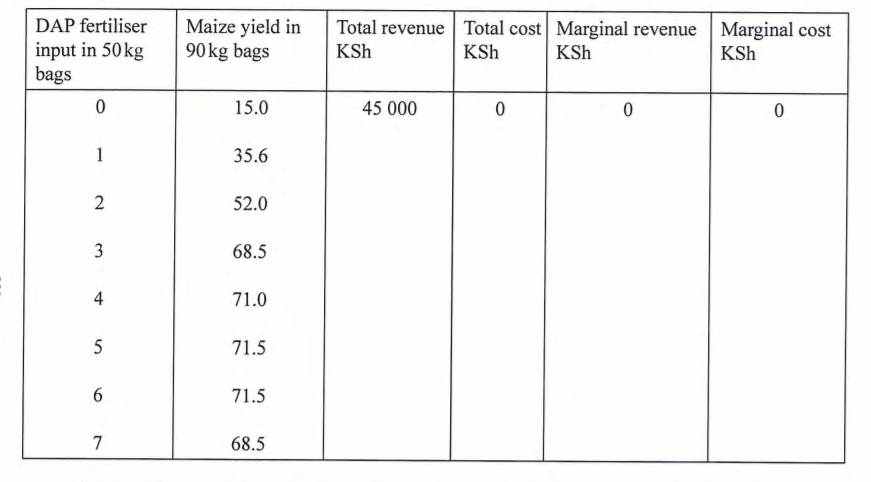
Kenya Certificate of Secondary Education
2018 Agriculture Paper 1
SECTION A (30 marks)
Answer all the questions in this section in the spaces provided.
1.Name four categories of livestock farming.(2 marks)
2.State four farming practices that ensure minimum tillage.(2 marks)
3.State four factors that determine the choice of water pipes used on the farm.(2 marks)
4.Name two sources of underground water.(1 marks)
5.Give four reasons why green manure is not commonly used in farming.(2 marks)
6.(a) Name two types of inventory records kept on the farm.(1 mark)
(b) State two uses of inventory records on a farm. (1 mark)
7.(a) Name three vegetative planting materials used for propagating pineapples. (1½ marks)
(b) State three qualities of certified seeds. (1½ marks)
8. State four advantages of using polythene sleeves to propagate stem cuttings.(2 mark)
9. State four disadvantages of concession land tenure system.(2 mark)
10. Name four insect pests of beans in the field.(2 marks)
11. (a) Name three legume pastures grown in high altitude areas. (l½ marks)
(b) State four management practices undertaken to improve natural pastures. (2 marks)
12. (a) Name two subsidiary books of the journal.(1 mark)
(b) State four item details contained in a sales receipt.(2 mark)
13. State four roles of Young Farmers Clubs in Kenya.(2 mark)
14. (a) What is meant by the term agroforestry? (½ mark)
(b) Name two agroforestry practices.(2 mark)
SECTION B (20 marks)
Answer all the questions in this section in the spaces provided.
15. The diagram below shows a section of a plant from which the planting material illustrated was obtained.
(a) Identify the planting material illustrated. (1 mark)
(b) Give two reasons why only the middle part of the plant was used to prepare the planting material. (2 marks)
(c) Apart from using the middle part of the plant, explain two precautions that should be observed when preparing the illustrated planting material. (2 marks)
16. An experiment was carried out to investigate soil constituents as described below:
Step I — An empty evaporating dish was weighed and its mass was 10 gms.
Step II — Fresh garden soil was put on the evaporating dish and weighed. The mass was 40 gms.
Step III — The evaporating dish containing fresh soil was put in an oven and heated at a temperature of 105 °C for 30 minutes, cooled and then weighed.
The mass was 35 gms.
Step IV — The dish containing soil was then strongly heated on a Bunsen burner for two hours while stirring. It was then cooled and weighed. The new mass was 32 gms.
(a) Give a reason why the soil was heated
(i) at 105 °C
(ii) strongly for two hours
(b) Calculate the percentage content of the soil constituents investigated in the experiment. (3 marks)
17. The diagram below illustrates a nursery practice.
(a) Name the practice
(b) Give a reason why the tool labelled E is important in the practice illustrated. (1 mark)
(c) What is the appropriate stage of growth for carrying out the illustrated practice in agroforestry? (1 mark)
(d) Explain two activities that ensure that the illustrated practice is carried out successfully.(2 marks)
18. In a maize production enterprise carried out over a period of eight years, a farmer used one hectare of land each time and applied different quantities of DAP fertiliser.
DAP fertiliser costs KSh 2 500 per 50kg bag and the harvested maize is sold at KSh 3 000 per 90kg bag. The quantities of DAP fertiliser applied and maize harvested are as shown in this table below.

(a) Complete the table by determining the values of total revenue, total cost, marginal revenue and marginal cost. (2 marks)
(b) From the information in your table, how can the farmer determine the level of production at which profit is maximum? (1 mark)
(c) At the production level that yielded maximum profit, what was the value of each of the following?
(i) DAP fertiliser input(1 marks)
(ii) Marginal revenue(1 marks)
SECTION C (40 marks)
Answer any tiro questions from this section in the spaces provided after question 21.
19. (a) Explain six farming practices that destroy soil structure. (6 marks)
(b) (i) State four functions of calcium in plant growth. (4 marks)
(ii) State four disadvantages of using inorganic fertilisers in crop production. (4 marks)
(c) Describe six categories of pesticides based on mode of action.(6 marks)
20. (a) Explain six cultural methods of soil and water conservation.(6 marks)
(b) Explain four environmental factors that influence effectiveness of herbicides.(8 marks)
(c) Describe six post-harvest practices for dry beans.(6 marks)
21. (a) (i) Describe the harvesting and marketing of bulb onions.(6 marks)
(ii) State the precautions that should be observed when harvesting cotton.(4 marks)
(b) Explain five problems associated with agricultural credit.(5 marks)
(c) Explain five principles that govern the formation and functioning of farmer’s co-operatives.(5 marks)